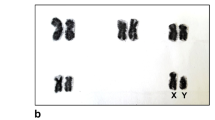Summary
Chromosome numbers of Phytoseiulus persimilis. Amblyseius fallacis, and Typhlodromus caudiglans were determined in lacto-propionic orcein squashes of developing eggs. Eggs of all species had either four or eight chromosomes: this indicates arrhenotoky (2 n = 8). All chromosomes are acrocentric; one of P. persimilis and one of A. fallacis had a lighter staining area suggestive of heterochromatin.
Similar content being viewed by others
References
Ballard, R. C.: The biology of the predaceous mite Typhlodromus fallacis (Garman) (Phytoseiidae) at 78° F. Ohio J. Sci. 54, 175–179 (1954).
Camin, J. H.: Observations on the life history and sensory behavior of the snake mite Ophionyssus natricis (Gervais) (Acarina: Macronyssidae). Chicago Acad. Sci. Spec. Publ. 10, 1–75 (1953).
Chant, D. A.: Phytoseiid mites (Acarina: Phytoseiidae). Part I. Bionomics of seven species in southeastern England. Canad. Entomologist 91, Suppl. 12, 1–44 (1960).
Cooper, K. W.: Reproductive behaviour and haploid parthenogenesis in the grass mite, Pediculopsis graminum (Reut.) (Acarina, Tarsonemidae). Proc. nat. Acad. Sci. (Wash.) 23, 41–44 (1937).
Davis, G. E.: Parthenogenesis in the argasid tick Ornithodoros moubata (Murray, 1877). J. Parasit. 37, 99–101 (1951).
Dosse, G.: Aus der Biologie der Raubmilbe Typhlodromus cucumeris Oud. (Acar., Phytoseiidae). Z. Pflanzenkr. 62, 593–598 (1955); - Morphologie und Biologie von Typhlodromus zwölferi n. sp. (Acar., Phytoseiidae). Z. angew. Entomol. 41, 301–331 (1957).
Dyar, A. F.: The use of lacto-propionic orcein in rapid squash methods for chromosome preparations. Stain Technol. 38, 85–90 (1963).
Filipponi, A.: Un nuovo caso di arrenotochia nei macrochelida (Acarina, Mesostigmata). Riv. Parassit. 16, 146–168 (1955); - Arrenotochia in Macrocheles subbadius (Acarina, Mesostigmata). R. C. Ist. sup. Sanità 20, 1038–1044 (1957).
Gatenby, J. B., and H. W. Beams: The microtomist's vademecum, Eleventh edit. London: J. & A. Churchill Ltd. 1950.
Herbert, H. J.: Laboratory studies on some factors in the life-history of the predacious mite Typhlodromus tiliae Oudms. (Acarina: Phytoseiidae). Canad. Entomologist 88, 701–704 (1956).
Jary, S. G., and J. H. Stapley: Investigations on the insect and allied pests of cultivated mushrooms. VI. Observations on the Tyroglyphid mite Histiosoma rostro-serratus Mégnin. J. S.-E. agric. Coll. Wye 38, 67–74 (1936).
Kennett, C. E.: Some predacious mites of the subfamilies Phytoseiinae and Aceosejinae (Acarina: Phytoseiidae, Aceosejidae) from central California with descriptions of new species. Ann. entomol. Soc. Amer. 51, 471–479 (1958).
Oliver jr., J. H., J. H. Camin and R. C. Jackson: Sex determination in the snake mite Ophionyssus natricis (Gervais) (Acarina: Dermanyssidae). Acarologia 5, 180–184 (1963).
Opperman, E..: Die Entstehung der Riesenspermien von Argas columbarum (Shaw) (reflexus F.). Z. mikr.-anat. Forsch. 37, 538–560 (1935).
Pätau, K.: Cytologische Untersuchungen an der haploidparthenogenetischen Milbe Pediculoides ventricosus. Newp. Berl. Zool. Jb., Abt. Anat. u. Ontog. 56, 277–322 (1934).
Putman, W. L.: The plum nursery mite (Phyllocoptes fockeui Nal. and Trt.). Ann. Rep. entomol. Soc. Ontario 70, 33–39 (1939); - Life-history and behaviour of the predacious mite Typhlodromus (T.) caudiglans Schuster (Acarina: Phytoseiidae) in Ontario, with notes on the prey of related species. Canad. Entomologist 94, 163–177 (1962).
Schrader, F.: Haploidie bei einer Spinnmilbe. Arch. mikr. Anat. 79, 610–622 (1923).
Skaliy, P., and W. J. Hayes: The biology of Liponyssus bacoti (Hirst 1913) (Acarina: Liponyssidae). Amer. J. trop. Med. 29, 759–772 (1949).
Smith, L. M., and F. M. Summers: The structure and biology of the red spider predator, “Hypoaspis” macropilis (Banks). Proc. entomol. Soe. Washington 51, 209–218 (1949).
Whiting, P. W.: The evolution of male haploidy. Quart. Rev. Biol. 20, 231–260 (1945).
Author information
Authors and Affiliations
Additional information
Contribution No. 93.
Rights and permissions
About this article
Cite this article
Hansell, R.I.C., Mollison, M.M. & Putman, W.L. A cytological demonstration of arrhenotoky in three mites of the family Phytoseiidae. Chromosoma 15, 562–567 (1964). https://doi.org/10.1007/BF00319990
Received:
Issue Date:
DOI: https://doi.org/10.1007/BF00319990




